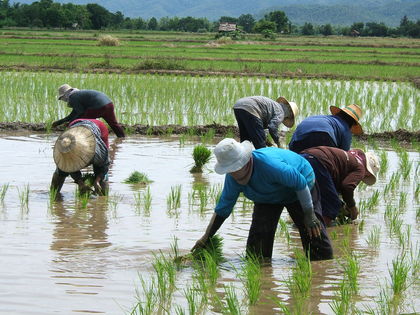Considering Vietnam as a case study of National Aesthetics, the country had “two decades of rapid growth following the adoption of Doi Moi or ‘economic renovation’ announced in December 1986” (Pincus 29). However, Vietnam has not been growing very fast since 2007. Vietnam is still dependent on the imports from China, such as fabric, steel, and chemicals, that it does not show interests in competing against the Chinese producers and other upstream industries. It exported a lot of footwear in 2011 that it was in third place behind China and Hong Kong, but the country was still growing slowly. Besides exporting footwear, Vietnam exports large amounts of agriculture especially green coffee and rice, but the crops are cheap and the quality is not that good. This indicates that agriculture may be a plausible branding project that reflects Vietnam’s aesthetics, but Vietnam would need to increase its strengths and decrease or change the weakness into strength. A weakness that is related to agriculture is how the companies discourage the links between the producer, processor, and consumers. By changing the agricultural process, Vietnam can use agriculture to brand their country in a positive light and grow faster.
Moreover, transnational education may be a plausible branding product for Vietnam since it can help expand education in the country. Having an education from an institution from another nation can increase a person’s knowledge and find other ways to solve problems. However, the Vietnamese government is not branding transnational education in an affective way that it has become “complex, ambiguous, opaque and poorly implemented and monitored” (Nguyen & Shillabeer 644). They are just tell the whole world that they have transnational education instead of enhancing the education. As a result, Vietnamese students are not getting good service quality for their education.
Some countries, like China, Europe, and the U.S., could help facilitate Vietnam’s development since these countries have some relations with Vietnam and are more developed as a country. These countries could give some tips to Vietnam so that they could strengthen their brands and decrease their weaknesses. Many times, these are also the countries where Vietnamese students would want to study from. The knowledge that the Vietnamese students bring back to Vietnam can help the country develop more and understand other nations better that there are less conflicts.
Question: How come Vietnam have not shown much interest in competing with Chinese producers and other upstream industries in things like yarn, cloth, and steel?
Works Cited
http://www.nationsencyclopedia.com/photos/vietnam-agriculture-1349.jpg
Nguyen, G., & Shillabeer, A. (2013) Issues in Transnational Higher Education Regulation in Vietnam. Proceedings of the International Conference on Managing the Asian Century, 637-644.
Pincus, J. (2015). Why Doesn’t Vietnam Grow Faster? State Fragment and the Limits of Vent for Surplus Growth. Journal of Southeast Asian Economics, 32, 26-51.

No comments:
Post a Comment